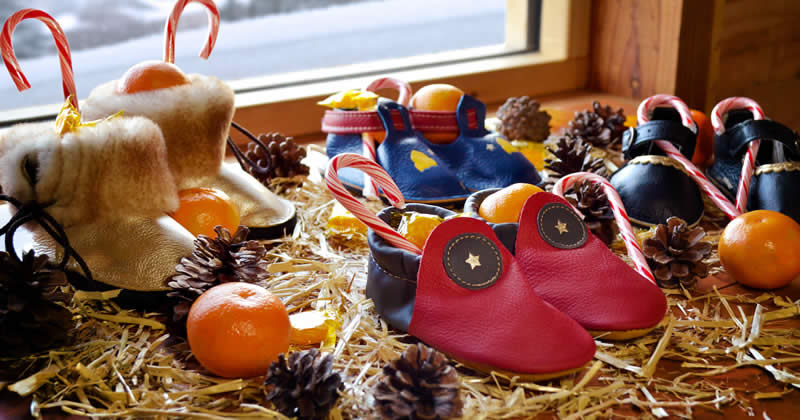The genesis of the gift-giving tradition can be traced back to the tales of St. Nicholas. A 4th-century bishop from Myra (modern-day Turkey), he was venerated for his extraordinary generosity and habit of gifting anonymously. One particular legend tells of him tossing purses of gold through a window, which then landed in stockings drying by the fire. This story sparked a tradition that persists even today and initiated the customs we associate with Christmas gift-giving.
Fast forward a few centuries, the story of St. Nicholas, now canonized as a saint, crosses borders, capturing imaginations far and wide. His tales were carried by Dutch immigrants to America where they evolved into the jolly figure of Santa Claus we know today. The Festive sacks of presents and colorful costumes. It all became synonymous with joyous laughter as a popular symbol of Christmas. As Santa Claus gained popularity, so too did the idea of receiving gifts in stockings, emulating that early tale of St. Nicholas’ benevolent act.
The transition from Stockings to Bags

While the stocking tradition was cherished and continues in many homes, a transformation was on the horizon, as stockings began to morph into a more flexible and capacious form – the bag of presents. This evolution was not sudden, but a gradual change necessitated by practical needs. Over time, presents started to diversify and increase in size, and it became evident that stockings, with their restrictive dimensions, were no longer a feasible solution. Thus, began the shift towards more accommodating gift bags.
Paralleling the growing diversity in presents, the bag served as an adaptable medium to cater to varying shapes and sizes, offering greater convenience. Crafted from an array of materials like cloth, paper, and later, plastic, these bags introduced a fresh dynamic to the traditional Christmas celebrations. They also brought with them a fresh avenue for creativity, enabling individuals to personalize their gifts with unique designs, colors, and messages, thereby enhancing the gifting experience.
Early Examples of Christmas Sacks
The early examples of Christmas gift bags were strikingly different from the mass-produced versions we see today. Often, they were simply cloth sacks, homemade and adorned with care. This humble beginning mirrored the spirit of Christmas, embodying the joy of giving and receiving. Gift sacks were initially filled with simple items like fruits, nuts, sweets, and small homemade crafts – a stark contrast to today’s tech gadgets and store-bought toys.
Despite their simplistic nature, these early gift bags held immense sentimental value. They were tangible tokens of love, imbued with a sense of warmth that was shared during the season of goodwill. Moreover, their reusable nature made them a sustainable choice, especially in an era when recycling wasn’t yet a popular practice. Indeed, these sacks were more than just vessels for gifts; they were an integral part of the celebration.
Influence of Commercialization on Gift Bag Trends

As the decades passed, the widespread commercialization of Christmas started to cast its influence on gift bag trends. Companies quickly recognized the potential of these vessels as an effective tool for branding and promotion. The once humble and homemade gift bag started to transform into a more standardized, mass-produced commodity, often emblazoned with company logos, festive designs, and catchy slogans.
This shift was not merely aesthetic. The commercialization of gift bags altered their contents too. Out went the homemade trinkets and sweets, replaced by factory-made toys, electronics, and branded merchandise. This shift, while offering variety, also led to a certain homogeneity in the gifts we give and receive. Yet, amidst the glitter of commercialization, the fundamental spirit of the gift bag – that of giving and sharing joy – remains undiminished.
Evolution of Santa Sacks in Different Cultures
Interestingly, while the gift bag evolved in response to commercial influences, it also adapted to diverse cultural interpretations. The ‘Santa sack‘ concept was adopted and reshaped by different societies, each infusing it with its unique cultural flavor. In some European cultures, for instance, children leave shoes out to be filled with gifts, a variant of the stocking and gift bag traditions.
Elsewhere, like in Australia, where Christmas coincides with summer, Santa sacks often take the form of beach bags filled with summer-related gifts. In other cultures, where Christmas is a newer tradition, the gift bags may come adorned with local symbols and motifs, thus blending global and local customs. This cultural adaptation of Santa sacks underscores the power of traditions to evolve while embracing diversity.
Symbolism and Significance of Gift Bags in Christmas Celebrations

From the time of St. Nicholas, the act of giving has been a potent symbol of love, generosity, and goodwill, and the gift bag, a silent participant in this exchange, holds significant symbolism. In its varying forms – from the stocking to the Santa sack – it has been a vessel of joy, bearing tokens of affection and care. While the contents may have changed over time, the essence of the tradition has not.
The gift bag also symbolizes anticipation and surprise. It is a testament to the excitement of discovering what’s within and the happiness that unfolds thereafter. Whether it’s a child waking up early to rummage through a Santa sack or an adult unwrapping a thoughtfully chosen gift, the gift bag enhances the emotional richness of these moments, adding a dash of magic to the festivities.
Role of Gift Sacks in Modern-Day Christmas Traditions
In our modern era, where the culture of gifting has transformed significantly, the role of gift bags remains central to Christmas traditions. Now, they’re not only carriers of presents but have also become gifts themselves, with many individuals investing in high-quality, reusable bags, often personalized with names or monograms. These bags, filled with a selection of thoughtfully chosen items, can become heirlooms, passed down through generations.
Beyond their functional use, gift bags also play a critical role in concealing the surprise, thus upholding the age-old tradition of mystery that is a hallmark of Christmas gift-giving. Despite the rise of e-commerce and direct gift delivery, the allure of a tangible, beautifully wrapped present still holds sway, keeping the tradition of gift bags alive and thriving.
Popularity and Adoption of Gift Bags Worldwide

Around the globe, the popularity and adoption of Christmas gift bags continue to flourish. From the grand bazaars of Istanbul to the glitzy malls of New York, the sight of individuals clutching festive gift bags is a universal symbol of the holiday season. Today, gift bags come in all shapes, sizes, and designs, each a testament to the evolving nature of this tradition.
Final Thoughts
While their aesthetic and contents may vary, the joy that a gift bag brings remains a shared experience. Whether it’s the excitement of an Australian child unearthing beach toys from a Santa sack or a German child discovering homemade cookies in a cloth bag, the sentiment remains the same. Regardless of borders and cultures, the Christmas gift bag, in all its avatars, continues to carry the universal message of love, goodwill, and the joy of giving – the very essence of Christmas.
